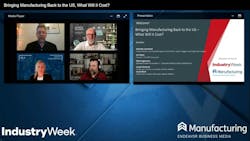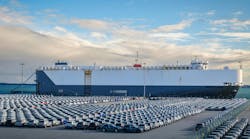Building New Facilities to Avoid Tariffs Won’t Be Easy
President Donald Trump wants high tariffs on imports to encourage companies to make products in the United States. However, doing so will be a challenge, engineering and building experts say. There aren’t a lot of buildings available nationwide to serve as factories, the costs to build new facilities are climbing and the prices of production equipment are on the rise as well.
On June 4, Endeavor Business Media’s Manufacturing Group held its second roundtable discussion on how tariffs are impacting manufacturers. A big message from the experts: If you haven’t priced a new facility or a plant upgrade recently, expect some sticker shock. Inflation isn’t just for eggs.
“When you look at the cost of a machine tool versus five years ago, you might have paid $1 million in 2018, 2019, 2020. That's going to cost $1.3 million, $1.4 million in today’s market,” said Jim Mayer, founder of the MFG Connector, a manufacturing communications consultant with a long history in the machine tools space.
Panelists for the live event were:
- Mayer
- Joseph Windover, construction solutions executive at coatings giant Sherwin-Williams
- Michelle Comerford, project director and supply chain practice leader at site selection firm Biggins Lacy Shapiro & Co.
- Matt Stagemeyer, national director of operations for consumer products at construction engineering company Burns & McDonnell
- Tom Wilk, editor-in-chief of Plant Services
Click here to watch the full webinar.
Windover noted that many if not most industrial construction projects are behind schedule at the moment, based on research that Sherwin-Williams did in partnership with Endeavor Business Intelligence, also part of Endeavor Business Media.
“49% said that their biggest challenge is managing schedules and meeting project timelines. 87% of those respondents have experienced construction delays on their projects. Just think about that. Nearly nine out of 10 projects are running behind schedule,” Windover said. He added that material shortages were driving most of the delays. “Here’s what's particularly concerning for our industry… 72% of the respondents reported that project delays affected their budget by 6% to 20%. These are multi-billion-dollar projects in some cases.”
Comerford said some businesses may be tempted to look for existing structures, but that may not be a practical solution.
“Starting with all the COVID disruptions that started in 2020, there’s been a lot of manufacturing investment activity into the U.S., so a lot of the building inventory that was out there prior to largely got gobbled up,” Comerford said. Inflation then made building too expensive and many developers paused construction efforts to see if market condition would improve. “We’re definitely seeing more inventory come online. The challenge is that some of that is designed for distribution use as opposed to manufacturing.”
“Demand is higher than what the construction industry can provide. On top of that, material costs continue to rise. The US imports about 20% of our steel and 30% to 40% refined copper… The administration [just] announced that they plan to increase those tariffs up to 50%. So, there's a lot of upward cost pressure,” Stagemeyer said. Add to that skilled worker shortages. Then, there’s competition for construction crews for the fastest-growing segment of the tech world – data centers.
“They're gobbling up a lot of the electrical components, a lot of the copper…. We just completed our projects in Ohio and the labor there, electricians and pipe fitters, was relatively available. And then, one of the big companies announced that they’re building a $2 billion data center about an hour and a half up the road, and suddenly that’s the job site of choice.”
Once you get the factory built, Mayer stressed that challenges don’t go away when it’s time to source equipment. As he noted earlier, tool prices are up sharply.
“I don't even think we’ve seen the top point of where pricing is going to go for the capital expenditure side of machine tools and things of that nature,” Mayer said. “I don't see it going down in nine, 12 or even 18 months. I think that we’re still trending upward on those European models.”
Stagemeyer also stressed that the challenges the panelists discussed can be overcome.
“We’re talking a lot about challenges, and I don’t want to give anybody in the audience the impression that anything is impossible,” Stagemeyer said. “Understanding the challenge, having partners in the industry that understand you and understand the industry, all of those can help you overcome any of these challenges.”
About the Author
Robert Schoenberger
Editor-in-Chief
LinkedIn: linkedin.com/in/robert-schoenberger-4326b810
Bio: Robert Schoenberger has been writing about manufacturing technology in one form or another since the late 1990s. He began his career in newspapers in South Texas and has worked for The Clarion-Ledger in Jackson, Mississippi; The Courier-Journal in Louisville, Kentucky; and The Plain Dealer in Cleveland where he spent more than six years as the automotive reporter. In 2014, he launched Today's Motor Vehicles (now EV Manufacturing & Design), a magazine focusing on design and manufacturing topics within the automotive and commercial truck worlds. He joined IndustryWeek in late 2021.



